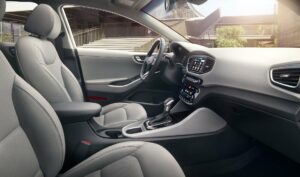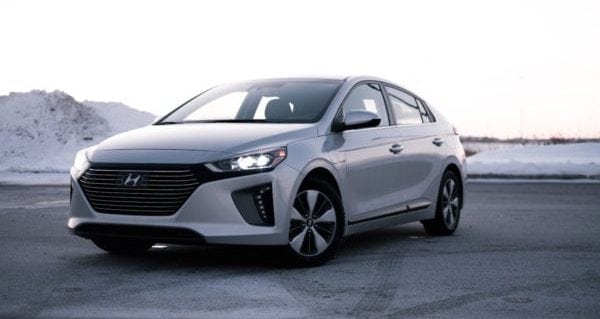
Offered in four trim levels – Blue, SE, Limited and Limited Tech – as well as the plug-in hybrid electric vehicle, the Hyundai Ioniq is powered by both a permanent magnet electric motor and a 1.6-litre, 104-horsepower, four-cylinder engine. Combined power output is 139 horsepower and the transmission is a six-speed dual clutch set-up.
Thankfully, hybrid cars are no longer headline news. In fact, any manufacturer worth its salt has a hybrid model of one type or another on the market these days. Some – Toyota, for example – have multiple models.
And hybrid cars, once categorized as bridge technology – that is, bridging the gap between conventional internal combustion cars and fully electric battery-mobiles – are here to stay and becoming more refined with each passing model year.
For proof, look no further than the taxi fleet of any major city. In Vancouver, for example, at least 90 per cent of the taxis are hybrid models, usually Toyota products, and it’s not unusual for these well-used people carriers to rack up half a million kilometres in their service life. Toyota, it’s safe to say, has mastered the art of hybrid technology and the Prius is the benchmark by which all others are judged.
That includes the Hyundai Ioniq, which debuted in North America last year.
Offered in four trim levels – Blue, SE, Limited and Limited Tech – as well as the plug-in hybrid electric vehicle (PHEV), which is what I drove, the Ioniq is powered by both a permanent magnet electric motor and a 1.6-litre, 104-horsepower, four-cylinder engine. Combined power output is 139 horsepower and the transmission is a six-speed dual clutch set-up. Hyundai is giving the Ioniq a combined fuel economy rating of 4.1 litres/100 kilometres, and the battery pack is lithium-ion polymer.

My Limited model had heated seats, heated steering wheel, leather interior, climate control and more, as well as the usual roster of safety features, including blind spot detection, rear parking assist and lane departure warning.
As you would expect from any Hyundai, the standard equipment level is high with the Ioniq. My Limited model had heated seats, heated steering wheel, leather interior, climate control and more, as well as the usual roster of safety features, including blind spot detection, rear parking assist and lane departure warning. I disabled the latter function as soon as I could find the button. I’ve grown to really dislike this particular feature. I don’t need the car to tell me when I’ve strayed too far into the other lane, and I really don’t appreciate it when it tries to take over the vehicle’s steering, as subtle as it may be. Harrumph. On the other hand, the blind spot detection is an excellent feature and I’ve grown to really appreciate it.
Behind the wheel, no nasty surprises and surprisingly normal switch gear and ergonomics. A little graphic to the left of the speedometer lets the driver know whether they are in “eco” mode and the Ioniq feels like most other Hyundai products once underway.
However – with a capital H – this car has an energy crisis. It’s one of the most underpowered cars I’ve driven lately and it’s not helped by an uneven power delivery that often has the engine revving gaily away but producing little forward momentum. On steep hills, it really struggles and doesn’t have that highway inertia necessary for effortless freeway cruising. Simple manoeuvres like parallel parking, where going back and forth between reverse and drive as you position the car, are unnecessarily clumsy. Hyundai needs to deal with this. By comparison, the Toyota Prius is a regular powerhouse.
That said, the Ioniq is a hybrid car, after all, with the onus on fuel economy rather than performance. Hyundai is actually touting it as “Canada’s most fuel efficient car” and claims you can drive more than 1,000 kilometres on a single tank of fuel. You can also take it up to a purported 120 km/hour on pure electric power before the gas engine kicks in.
And it has a decent amount of storage space. Pop the rear hatch and 750 litres (26.5 cubic feet) of space is revealed. That’s comparable to most similar models, hybrid or no.
One thing: towing is “not recommended,” but that’s the case with virtually all hybrid cars.
After a week with the Ioniq, I definitely appreciated its frugality. The less time spent at the pump, the better. But I came away feeling that the Prius has still a leg up in most respects. Yes, it’s a bit more expensive but it’s a proven commodity, and that’s something that Hyundai is just going to have to deal with.
2018 Hyundai Ioniq
Engine: 1.6-litre four-cylinder/43-horsepower electric motor
Transmission: six-speed automatic
Drive: front-wheel drive
Combined horsepower: 139
Torque: 195 foot pounds
Price as tested: $38,204
Fuel economy: 4.3 litres/100 km (city) and 4.0 (highway), regular fuel
Some alternatives: Toyota Prius, Chevrolet Volt, Honda CR-Z, Kia Optima Hybrid, Toyota Camry Hybrid, VW Jetta Turbo Hybrid
Ted Laturnus has been an automotive journalist since 1976. He has been named Canadian Automotive Journalist of The Year twice and is past president of the Automotive Journalists Association of Canada (AJAC).
The views, opinions and positions expressed by columnists and contributors are the author’s alone. They do not inherently or expressly reflect the views, opinions and/or positions of our publication. Troy Media is a Troy Media Digital Solutions Associate website.


